
Henze-Harvestore, a partner of generizon, specializes in the design and manufacture of steel tanks for the storage of drinking water or the treatment of liquids. Henze-Harvestore/generizon offers you stainless steel or duplex tanks, enameled steel tanks and epoxy steel tanks.
Bolted tanks can be supplied in any size and shape up to a volume of 25,000 m³. The material of the tank is selected according to the ingredients of the medium to be stored. In most cases, the choice will be between trifusion, ASI 304 and ASI 316. Other grades of stainless steel and enamelled quality are available.
With its technical expertise and commitment to sustainability, the company offers solutions in the areas of drinking water storage, wastewater treatment, agriculture, and biogas.
bolted steel tanks.
The tanks are constructed from bolted steel segments, using a wide range of steel materials, coated or uncoated, including enamelled steel and stainless or duplex steel for the most demanding cases. The choice of material depends on what needs to be stored. Solids, liquids or gases, almost anything can be stored in Henze-Harvestore tanks, guaranteeing optimum durability and strength. 60 years of experience guarantees quality. More than 90,000 tanks and silos in over 110 countries speak volumes.
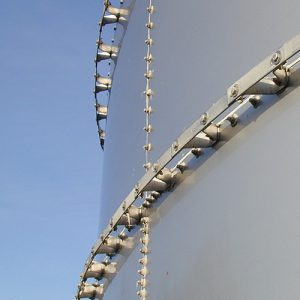
advantage of a prefabricated steel tank.
Bolted tanks are constructed from prefabricated panels, allowing for rapid assembly on site. This significantly reduces installation time compared to welded or concrete tanks.
The prefabricated nature of bolted tanks generally makes them less expensive and also makes repairs and structural modifications easier, resulting in cost savings over the entire life cycle. Individual panels can be easily replaced, tanks can be expanded or relocated as required.
stainless steel tanks.
Stainless steel tanks are widely used for liquid storage in several industrial sectors due to their high corrosion resistance, increased longevity and high hygiene, making them ideal for storing drinking water, food, chemical or industrial liquids.
Different types of stainless steel are used depending on specific needs.
- Stainless steel 304 (V2A) is suitable for storing drinking water, foodstuffs and certain chemicals.
- Stainless steel 316 (V4A) is recommended for highly corrosive environments such as the chemical and maritime industries.
- Duplex, on the other hand, combines exceptional mechanical and chemical resistance.
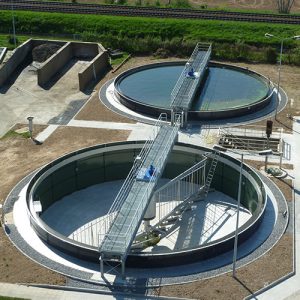
enamelled steel / glass fused steel / glass lined steel tank.
Steel enameling is a thermal process in the enameling furnace at over 800°C. A glass layer is formed on the outside which strongly bonds to the steel during a physicochemical fusion process. The result is a tank that combines the strength of steel plates with the excellent anti-corrosion capabilities of glass.
Several types of enameling, quality standards (internal surfaces) are offered.
- HHG3, the high range, layer thickness 260-460 µm, 3 layers, 2 x burns, pH 2-11, test (without pores) 1100V EEA 7.20 / EN28765:2011, certified EN ISO 28765:2016, NSF/ANSI/CAN 61, for drinking water, storage and treatment of municipal sludge, parts exposed to the gas zone, food effluents, leachate.
- HHG2S, an established cost-effective solution that offers proven safety and protection, layer thickness 200 – 360 µm, 2 layers, 1 x burn-through, pH 3-9, test (pore-free) 700V EEA 7.20/ AWWA D103-97/ EN28765:2011, for potable water storage, cathodic protection (NSF/ANSI/CAN 61, DWI, Reg 31 certified), edible oil, dry solids, sludge storage, etc.
- HHG2, for potable water, agricultural slurry, wet grain and fodder silos, 180 – 360 µm, 2 layers, 1 x burn-through, pH 4-8.
Advantages of enameled steel.
- Glass protects against corrosion.
- Steel provides strength and flexibility.
- Resistant to impact and abrasion.
- Hygienic surface. No bacteria on the surface.
- Temperature resistant.
- 30-year life span and proven life span in some applications exceeding 60 years.
- Independently certified, prefabricated enamel panels meet or exceed the requirements of international enamelling standards.
epoxy coated steel tank.
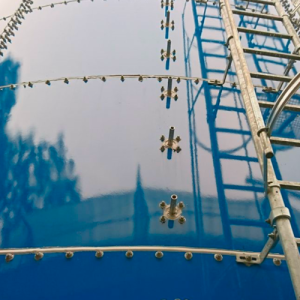
Epoxy coating is a protective layer applied to a steel surface, to improve its resistance to corrosion, chemicals (making it suitable for industrial environments) and wear. It is composed of thermosetting epoxy resins, which, once cured, form a waterproof and durable barrier.
Ideal for storing drinking water, wastewater sludge, these tanks represent a low-cost solution that offers good protection. Although they offer many advantages, it is important to note that their longevity is less than that of enameled steel tanks and that they potentially require more maintenance.
- HHG1S, industrial epoxy resin coating, layer thickness 150 – 250 µm, pH range: pH 3-13, test (pore-free) 1100V, solid storage, drinking water, filter tanks and municipal sludge storage.
- HHG1, basic epoxy resin, layer thickness 30 – 50 µm.
integral components of bolted tanks.
- Hot-dip galvanized steel bolts of grade 8.8 or 10.9. These bolts have a flat polypropylene head with a large diameter, ensuring an even distribution of the forces applied to the enamelled plate. Their coating is chemically resistant, hygienic and ensures a particularly effective seal on the glazed surface, thanks to their large contact surface.
- Sealing compounds selected according to the different applications in order to resist the abrasive effects of the chemicals concerned. Test certificates available.
accessories for bolted tanks.
An individual product requires special accessories. Accessories for tanks play a crucial role in their functionality, safety and adaptability to specific needs. Here are some common examples.
- Roofs and covers, gas-tight. Designed to minimize odors and prevent gas leaks. Available in stainless steel, aluminum, fiberglass or PVC.
- Cone. Available in 35°, 45°, 60° and 70° angles to facilitate the flow of stored materials.
- Steel construction. Hatches, flanges, portholes, ladders, platforms, spiral staircases, stair towers, steps, clear water channels, special components.
- Gas management systems. Pressure / vacuum valves, ballast plates with telescopic guides.
- Floor coverings. HDPE, stainless steel, coating, floor leak monitoring to ensure sealing and durability.
- Thermal insulation. Active or passive, depending on the storage requirements.
- Mixers and sensors. To ensure optimal homogenization of substrates and accurate monitoring of liquid levels.
areas of application of bolted tanks.
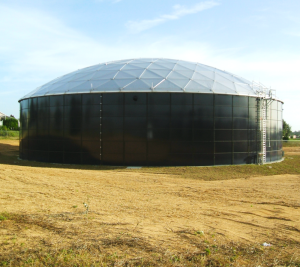
drinking water storage tanks for desalination plants.
Drinking water storage infrastructure projects are becoming increasingly crucial for countries in the Global South, such as Morocco. Decentralized water storage facilities are essential to meet the thirst of growing urban populations and agriculture.
Even when water is produced continuously from desalination, water demand fluctuates throughout the day and night, storage projects are essential for overall water management, purity, quality, pressure, peak supply, redundancy, etc.
A lot of energy, investment and effort goes into pumping water from far away, from underground aquifers, from the sea using desalination plant technologies, then conditioning and transporting it, and finally… We prepare the finest and most sacred good, drinking water, and it will be stored and preserved in the best and safest places, untouchable by the elements, this is what Henze-Harvestore/generizon offers.
Water storage tanks are suitable for industrial, municipal and agricultural needs.
- Potable water tanks.
- Water tanks for fire fighting.
- Tanks for industrial water.
- Tanks for agricultural irrigation.
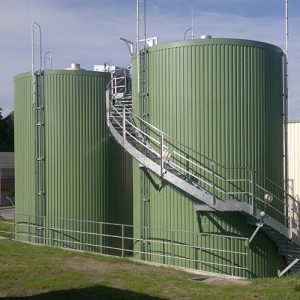
tank applications for wastewater treatment plants.
Available wastewater tanks have a capacity, up to 25,000 m³. They are manufactured from bolted segmented plates in 316 and 304 stainless steel, as well as enamelled or coated steel to ensure optimum corrosion resistance.
Bolted tanks are used for various stages of water treatment, such as clarification, thickening, biological filtration, aeration, membrane filtration (MBR), sludge management and stormwater storage.
These tanks can be used uncovered or covered, with a variety of materials available for the cover, such as stainless steel, aluminum, fiberglass (GFK) or tarpaulin. Different materials are also available for concrete floor protection, such as HDPE, stainless steel, fiberglass (GFK) and epoxy.
In addition, a wide range of individual components is available, including manholes, culverts, stairs, walkways, insulations and other special construction components to meet specific project needs.
storage tanks in the industrial sector.
These tanks are designed to meet the specific requirements of industries for the storage of solids, liquids and gases. They are ideal for industrial water, process water in the food sector, industrial wastewater treatment plants (WWTP) and the chemical industry, ensuring efficient preservation and optimal product management in demanding environments.
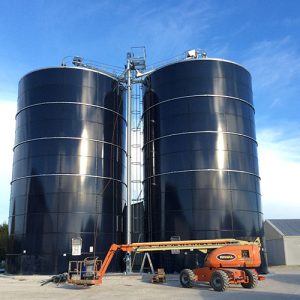
grain silos. application in agriculture.
Henze-Harvestore silos, constructed from bolted panels, offer a versatile storage solution for a wide range of agricultural products, such as maize, CCM (corn-crop-mix), fermented fodder and silage from maize. Their gas-tightness ensures optimum preservation of the quality of the stored products.
biogas.
Since 1980, Henze-Harvestore has been developing specialized tanks for biogas production, such as centrally stirred digesters and tanks with integrated gas storage.
Henze-Harvestore/generizon services.
Established in 1959, Henze-Harvestore brings decades of expertise to the construction of containers and tanks, specializing in enameled and stainless steel structures and the assembly of bolted tanks.
With a focus on Morocco and West Africa, Generizon offers expert knowledge of the water, waste, energy, and sanitation sectors, understanding the nuances of local issues.
Their strategic partnership allows these two companies to combine their expertise to offer optimal solutions: economical, efficient, durable and flexible bolted tanks, custom-designed to meet the specific needs of each customer.
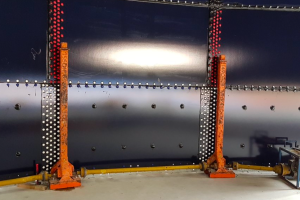
planning – consulting – delivery – rapid assembly of bolted tanks.
- Consulting. From the idea to implementation and construction.
- Expert service as a unique and practical solution.
- Comprehensive and personalised advice. On-site visit. The solutions we develop for you are always tailored to your individual needs and take into account all the factors that concern you.
- Preparation of the statics and construction design.
- Dimensioning and development of detailed plans.
- Establish all necessary accessories.
- Implementation of assembly.


